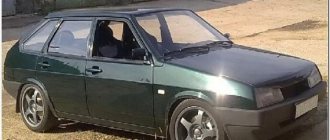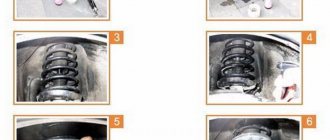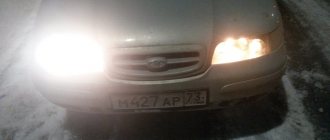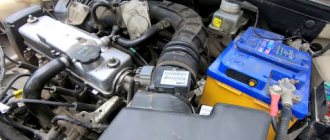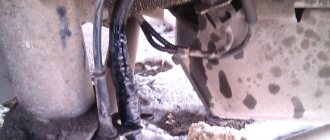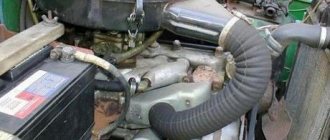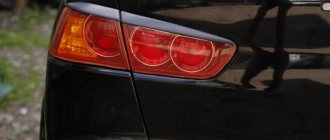Most modern and not so modern cars (be it an Opel Astra or a Subaru Legacy) have a huge amount of electronics inside, created for maximum driving comfort, additional traffic control, and avoidance of dangerous situations. The presence of problems is reported by indicators such as ESP (aka “anti-skid”), induction speed sensor (triangle), anti-wheel drive, handbrake indicator (exclamation mark), ESC (exchange rate control) sensor, and anti-lock braking system (ABS) light. Sometimes the indication works on its own, for no apparent reason. The flashing of the “garland” near the speedometer causes surprise and fear among both experienced motorists and beginners who have barely received a license and their own car. In this article we will look at one of the most common situations - when the ABS sensor is on.
Causes of ABS error
Why does the ABS light come on? This indicator is triggered for several reasons:
- incorrect operation of sensors in car wheels;
- problems with the anti-lock braking system control unit;
- malfunction of the cables responsible for signal transmission;
- the crown on the hub (front or rear), from which the ABS reads information, has deteriorated.
The signal can turn on both while driving and before driving, when the engine starts to start. Problems are common for those who like to drive off-road - the sensors get dirty with dust, dirt, moisture, strong shaking breaks the wires. The control unit will recognize such violations and the sign will light up on the dashboard instantly.
Sometimes the wrong actions of the car owner lead to a breakdown. Often, incorrect replacement of parts (wheel bearing, CV joint, pads, etc.) leads to the system starting to blink. At the same time, the handbrake, ASR, anti-skid and other “anti” indicators on the dashboard can spark. In this case, it is necessary to check whether the replacement was carried out correctly and whether problems arose when reinstalling the parts.
If you broke down on the way
In recent years, the production of Lada Kalina cars (ECU) of domestic production was replaced with Korean ones. The kind they put on Hyundai cars. After that, power steering failures became significantly less frequent. But they started installing Korean blocks on new cars.
Electric power steering for modern cars has already become an integral part of them. On the Russian market it was first installed on the Lada Kalina (VAZ 1118). The electric booster added both a lot of positive emotions and a lot of negative ones.
The situation is quite typical: the client complains that the electric power steering sometimes turns off and the electric power steering warning light comes on
This situation is very annoying, because not only the owner uses the car, but also his wife. It is much more problematic for a woman to turn the steering wheel without electric power assistance.
We start the car, and the electric power steering fault light actually lights up and it becomes quite difficult to turn the steering wheel. It is imperative to deal with this problem.
We connect the diagnostic scanner and connect to the EMUR control unit.
On the monitor screen we see the following error: C1044 – incorrect sequence of the rotor position sensor. What is a rotor position sensor and where is it located?
Let's take a break from our malfunction for a moment and touch on a little theory. Let's understand the EMUR device and what main parts it consists of. Let's consider all its parts separately.
- Steering shaft
- Electric motor
- Electronic control unit
- Torque sensor
- Rotor position sensor
Remove the steering wheel, steering column switches and ignition switch. To get to the torque sensor, you must first remove the electric motor. We unscrew the bracket with 4 bolts, the cardan shaft, the lock nut and the 3 bolts securing the electric motor.
This is what we got (Fig. 12)
New Lada: How to remove the center console and radio on Lada Kalina 2 » Lada.Online - all the most interesting and useful about LADA cars
Next we pull out the shaft.
We take out the torque sensor winding (Fig. 17), having previously unsoldered the wires from the board (Fig. 16).
Design of an inductive torque sensor.
The inductive sensor consists of two concentric cylinders with holes (perforation slots), which are fixed to the shaft and rotate with it. And two concentric coils with primary and secondary windings, fixedly inserted into the EMUR housing.
We will not go into various terminology, but let’s put it simply: an alternating current with a frequency of 20 kHz is supplied to the primary winding, and if we apply force to the shaft (that is, we begin to rotate the steering wheel), then a voltage “” or “-” appears on the secondary winding depending on the direction of rotation, and the magnitude of this voltage is directly proportional to the applied torque (force). Thus, the electronic control unit (ECU) determines with what force you rotate the steering wheel in one direction or another.
So, we’ve dealt with the torque sensor, let’s move on to the next one, namely the rotor position sensor (Fig. 20), which is located on the back cover of the electric motor.
The EMUR of the Lada "Kalina" uses a 3-phase switched inductor (brushless) motor. In order for it to start rotating in one direction or another, the electronics must understand what position the rotor is currently in and, after determining the position, apply voltage to certain stator windings at the right moments. To determine the position, a rotor position sensor (RPS) is used.
Diagram and design of an optical rotor position sensor.
3 optocouplers located at an angle of 120 degrees - LED (LED a,b,c) and photodiode (PD a,b,c), correspond to the location of the motor stator windings phases A, B, C. A disk is installed on the motor rotor, and when it rotates Photodiode a, b or c is triggered. In this way, the electronics determines the current position of the rotor.
New Lada: Front stabilizer Lada Largus 4601 – Avtopiter
Next, let’s look at the electronic control unit EMUR (Fig. 23), we won’t say anything special about it, we’ll just look at the photo of the board itself.
New Lada: Lada Kalina Cross (Lada Kalina Cross) experience in operating three cars, are they reliable? | Er... auto motorcycle tests
Well, we have sorted out the EMUR device, let’s return to our malfunction, with which the owner of the Kalina car came to us. What needs to be done to make everything work as it should? A fairly common malfunction with this modification of the EMUR is poor soldering of the optocouplers on the rotor position sensor board. It is enough to simply solder all the contacts of the optocouplers (Fig. 24) to revive the EMUR, which we hastened to do.
After soldering the board, we assemble everything in the reverse order and start the car. Hurray. The EMUR fault light went out and the steering wheel began to rotate very easily.
We have a scanner to check parameters and read fault codes, but what should a simple motorist who does not have this equipment do? How to count errors without a special scanner? It's quite simple.
In order to read the self-diagnosis codes of the Kalina EUR you need to:
1) With the ignition off, short the 6th contact of connector X2 of the EMUR control unit to ground, or short-circuit contacts 6 and 7 (Fig. 26). There is no 6th pin in connector X2, so we installed a piece of white wire there and connected it to the 7th pin (ground).
Let's look at the EMUR circuit for a more detailed understanding.
What to do if the ABS light comes on?
The anti-lock braking system is designed to eliminate possible problems while driving and prevent errors on the part of the driver when operating the pedal. When braking sharply, ABS will not allow the wheels to completely lock, excluding skidding, for example on slippery sections of the road - the car will gently reduce speed. If you see that the ABS light is on on the dashboard, reduce the pressure on the brake pedal. Then the car will do everything for you.
Important! The presence of such a system in a car is not a reason to accelerate on icy roads or drive quickly on a wet road. Remember that indicators, buttons and signals do not work if the driver is driving incorrectly.
A failure in the ABS means that the system will not work properly at the right time. In the best case, the car will hit an obstacle, in the worst, the outcome will be fatal.
Why is the abs system needed?
In short, ABS regulates the braking forces on each wheel so that the car's wheels do not lock when braking, but the car effectively stops. This way, if you brake hard enough, you will not lose control of the car.
If there is no system or it is out of order, then during sharp braking one or more wheels may lock and stop rotating (they skid). Which can lead to skidding, especially if you have to brake hard when turning.
In any case, if the ABS fault lamp is on, then the system is not working! You can easily check: accelerate to 40 km/h and sharply press the brake pedal to the floor. If there is no pedal vibration, the abs does not work.
If you have an anti-lock braking system, you can press the brake pedal hard and try to avoid an obstacle. Without ABS, if you slam on the brakes and try to avoid an obstacle, you may simply skid and hit the side of the car against the obstacle. This is short...
Options for self-diagnosis of the system if ABS lights up on the instrument panel
The on-board computer reports the presence of errors in the functioning of a particular unit. The display will show a code corresponding to the specific problem.
Important! The set of error codes and their designations vary. It all depends on the manufacturer. It is necessary to clarify the decryption in the user manual or on the Internet.
Diagnostics can be done on your own. You can do something from the list below.
- Self-control test. On a dry section of a normal road we accelerate to 100 km/h. Turn off the radio, close all the windows, listen carefully. Did you hear a cracking sound (from the front, rear, right or left side)? There may be play in the hub bearing.
- Visit to a car wash. During the cleaning process, instruct that special attention be paid to the discs and hubs. Thorough cleaning will eliminate the spontaneous ignition of the ABS check.
- Checking fuses. If the one responsible for the anti-lock braking system has burned out, replace it.
- We put the car on a jack, carefully examine the sensor area, and check the integrity of the cables. Noticed corrosion or dirt? We clean it carefully. After this, the ABS activation should disappear.
The most reliable way (and the most expensive) is to send the car for diagnostics to a service center. Thanks to special equipment, specialists can find faults quickly and accurately. Alternatively, you can take care of purchasing such equipment, but its price may be completely unaffordable for some.
Fixing the ABS light coming on
With proper timely diagnosis, it is quite easy to get rid of problems or adjust the operation of the system. During operation, the driver is able to influence the operation of the unit himself - through the ABS module pump or valves. In addition, a lot depends on the causes of the problems. Sometimes the ABS sensors and wires are working properly and are in the right place, but the module itself is acting up. In this case, there is only one way out - to change the module, since the manufacturer did not intend to repair it.
If the problem lies in a malfunction of the on-board computer, you need to reset the settings. But, of course, only after a complete check of the sensors, cables and module.
How to modify the design
To protect the wiring harness from the environment, you can use a D-shaped seal. We lay the wires in it and wrap it with electrical tape. We put everything in the corrugation. We glue the cover covering the ABS sensor connector around the perimeter with the same sealant. This will prevent moisture and dirt from entering the area where the sensor and connector are located.
Attention! If the ABS fails, the brakes remain operational, but the braking efficiency is reduced, which is especially dangerous on some surfaces. See why.
Share on social networks:
Found an error? Select it and press Ctrl+Enter..
How the ABS status indicator should work
Ideally, when the system is working properly and there are no problems, the ABS icon lights up when ignited. The machine simply checks the electronics, reporting this on the display - buttons with indicators begin to blink or light up. Having made sure that the signal is passing normally, the icon begins to go out a couple of seconds after startup. Sometimes the ABS continues to light up, sometimes the icon turns on while driving. This indicates a malfunction of the brake system. It is necessary to carry out an inspection and, if necessary, repairs.
Reasons why the ABS malfunction indicator turns on spontaneously
When the functions are performed correctly, the ABS light comes on, indicating that the wheels are unlocked. The electronic innards realized that the ABS needed to be turned on. The presence of other indicators (for example, ESP) will allow the car to cope with wet roads or ice on its own.
Usually the alarm is triggered due to a problem. This is when the ABS error light comes on:
- sensors are clogged with dust, moisture, dirt;
- the sensor is rusty;
- problems with the computer: the device lights up the indicators spontaneously, for no reason;
- the chassis is acting up, displacing the ABS sensor;
- The fuse has blown.
The ABS sign lights up in any car, regardless of its class, purpose or in which part the drive is installed - front, rear or both. As an example, the Volkswagen line of cars from the late 90s: in it, the ABS check was triggered, even if the fault did not concern the brake system.
Replacing ABS sensors
If the cause of the malfunction is not in the wiring, but in the ABS sensor itself, we replace it. To do this, first unscrew the fastening screw with a Torx T30 key, and then remove the sensor wiring harness from the bracket. The photo shows a Lada Vesta car; on other Lada models the work is performed in a similar way.
Instructions for replacing the front wheel ABS sensor:
Instructions for replacing the rear wheel ABS sensor:
Consequences of a faulty ABS
ABS, like any other element of a car, can wear out, losing reliability over time. The essence of the system is to ensure proper braking. Each wheel has a “personal” sensor, which allows you to gradually adjust braking and reduce speed without blocking all wheels at once. A system that is not working correctly will not be able to do this.
You can disable ABS, but you still shouldn’t do it. If the ABS does not perform its functions correctly, damage to the suspension may occur. An ABS lamp that comes on in an unusual situation threatens to cause the driver to simply lose control of the vehicle.
What to do in various situations if the ABS light is on on the instrument panel
When the ABS check light is constantly on, make sure that there are no problems with individual elements (diagnostic methods are provided above). If after repair the light does not go out, it may be necessary to reflash the ECU or pay attention to other components of the car - sometimes the system works if something else refuses to work.
Abandoning the system by turning it off is not the best option, especially for modern cars. In most models, ABS is connected to the chassis; disabling it will negatively affect the functioning of the entire vehicle.
The error code indicates a failure (open circuit or short circuit) in the speed sensor of a specific wheel (for example, rear right)
As mentioned above, each ABS wheel has a specific sensor. If an error code appears regarding a sensor failure on a specific wheel, do not rush to replace the sensor. There may have been a break - make sure the network cables are intact; perhaps the wire has come loose from the connector or is completely torn.
The error code indicates that there is no signal from a specific wheel rotation sensor.
The situation is similar to the previous one, but now the problem is with the sensor. The sensor should only be replaced if there is severe wear. The problem is sometimes caused by an incorrect sensor position. Consider the location of its installation, make adjustments, start the engine and drive off. If the problem persists, the icon will light up again.
Failure of pressure regulator solenoid valves
This malfunction affects the operation of the system as a whole. The icon will be continuously lit, and the ABS will not perform its functions correctly. Replacement with a working or completely new system is necessary.
Malfunction in power supply circuits
This case may be completely unrelated to an ABS malfunction (at least the diagnostics do not indicate them). The fuses need to be checked. Usually replacing the one responsible for the anti-lock braking system solves the problem.
Lack of communication via CAN bus
A serious problem because it affects the operation of electronics in general. The CAN bus is one thick wire connecting all nodes and circuits. Breaks that occur or movement away from the connector require contacting a service center. The constant absence of ABS signals and other sensors will indicate such a breakdown.
After bearing replacement
Motorist forums contain topics with the general title: “ABS lights up after replacement (insert part).” The problem often occurs after replacing the wheel bearings. It all depends on the make and model of the car. The problem is attributed to improper installation or damage during the process. It is also quite common for cables or the system sensor itself to be damaged. A re-opening and elimination of the problems that have arisen are required.
After replacing the hub
After replacing the hub, the anti-lock braking system goes crazy. As in the previous situation, damage to the wires and sensor is possible. If the system elements are intact, it is necessary to check the gap between the sensor and the comb of the newly installed hub - it should not exceed 1 mm.
After replacing the pads
Another possible option. Installation of new pads may also be accompanied by a malfunction of the system due to a large gap, broken cables, or damage to the sensor. The sensor may be clogged with lubricant - the problem can be eliminated by cleaning.
Issues discussed in the material:
- What is an ABS light bulb and what is it for?
- Why is the ABS light on?
- Why is the ABS light on and what should you check immediately?
It happens that a suddenly illuminated ABS light makes some motorists shudder nervously. They believe the entire braking system has failed. The puzzled car owner begins to look on the Internet for a way out of this situation. However, there is no need to panic. After all, the brakes may be normal, but malfunctions may occur only in the anti-lock braking system, which is not at all critical. The article discusses in detail the question of why the ABS light is on and what should be done to correct the situation.
How to repair wiring
We remove the wheel, and then the locker (for the front wheel, turning out the fastening screws) or the protective shield (for the rear wheel, turning out the two fastening nuts “10”). Press the latch and disconnect the block with wires from the ABS sensor. We inspect the connector and make sure there is no corrosion or damage. In case of damage, we restore the integrity of the wires:
We treat it with a special means for cleaning electrical contacts (for example, graphite grease) and clean the contacts from oxides. We clean the wheel speed sensor and the surface around the sensor from dirt.
Attention! Keep ABS sensors away from magnets as this may cause damage.
What is an ABS light bulb and what is it for?
The ABS system controls the braking of the wheels without locking them. Moreover, the car stops quite quickly. If the car owner is forced to brake sharply, thanks to the anti-lock braking system, loss of control of the car will not occur.
If the vehicle is not equipped with an anti-lock braking system, or it is inoperative, then when braking sharply, the wheels will block or stop rotating. This can lead to the car skidding, which is especially dangerous when turning. If the ABS light is on on the dashboard, this indicates a problem with the anti-lock system. It is very easy to check whether the anti-lock braking system is functioning. To do this, the car is accelerated to a speed of 40 km/h and the brakes are sharply pressed to the floor. If the pedal under your foot does not vibrate, it means that the ABS function is faulty - the indicator lights up. Thanks to the anti-lock braking system, you can suddenly “slam on the brakes” and then quickly go around an obstacle. If there is no ABS function, sharp braking and simultaneous avoidance of obstacles is impossible, since there is a high risk of the vehicle skidding.
The anti-lock braking system consists of the following elements:
- rotation sensors (all wheels of the car are equipped with them);
- hydraulic control unit;
- a special mechanism for monitoring the functions of the hydraulic unit;
- ABS light bulb located on the instrument panel.
Objective reasons why the ABS light may be on are errors on the instrument panel:
- When you start the car engine, all the lights on the dashboard light up, this indicates that the car’s systems are in operating mode. If the automation is fully operational, then within a few minutes all the icons on the display will go out. But when the ABS indicator does not light up when you start the engine, most likely the light bulb is not working.
- A long-burning ABS light indicates a malfunction in the anti-lock braking system. The malfunction is detected by the on-board computer, which recognizes and stores the fault code, and then turns on the signal indicator.
Next, we will talk in more detail about the situation in which the light indicates a malfunction and (or) error in the functioning of the ABS.
How does the ABS system work normally?
Let us remind you that ABS - Anti-lock Braking System
- in a car it prevents wheel locking and consists of a system of sensors that monitor the speed of the car and the rotation of its wheels, as well as a hydraulic unit and a control unit. The control unit processes the signal from the sensor, and the hydraulic unit distributes pressure to the brake pads.
The main task of the anti-lock braking system
- change the pressure in the brake system line so that, based on data on the speed of rotation of the wheels, the car can brake urgently and at the same time maintain controllability.
Modern ABS systems are reliable and are often paired with an EBD system that distributes braking forces. The most vulnerable point in the anti-lock braking system is the wheel sensor, because it is constantly exposed to contamination and shock, for example, when repairing wheel hubs.
You will understand that the ABS system is working in your Renault when, during intensive braking on a slippery surface, the brake pedal begins to vibrate (feel into your foot, jerking and jerking), and a characteristic cracking sound is heard.
Why the ABS light is on: main reasons
The main reasons why the ABS light on the instrument panel is on:
- there is no contact in the connected connector;
- there is no connection with any sensor, it is likely that the wire has broken;
- The ABS sensor is faulty, so it needs to be checked and, if necessary, replaced with a new one;
- the crown on the hub does not work;
- The anti-lock braking system control unit is faulty.
After a thorough inspection, identification and elimination of the probable source of the breakdown, it is necessary to check the operation of the ABS. To do this, accelerate the car to a speed of 40 km/h. Then you slam on the brakes. If the pedal vibrates and the error light does not light up, then all elements are working.
If, after a visual initial inspection of the sensors, wires, and control unit, no malfunction is identified and the light continues to light, you need to carry out computer diagnostics. Using this procedure, a specific error code issued by the system is detected.
Why does the ABS error appear?
Normally, the ABS light comes on immediately after starting the engine and goes out after a couple of seconds, when the on-board computer checks (and approves) the operation of the system itself.
If the light comes on while the Renault is in motion, or does not go out shortly after starting the engine, the reason may be that:
- ABS system fuse blown
- The ABS wheel sensor has failed - due to mechanical damage or a change in the gap between the sensor and the gear rotor
- contact with the system sensors is lost - the wiring is broken, the terminals are oxidized
- the voltage in the on-board network has dropped below 10.5 V (the battery is dead, the generator is not working, etc.)
- The hydraulic pump motor has failed
- The hydraulic valve or ABS control unit has failed (rare failure).
Also, the ABS lamp may light up after an illiterate repair of your Renault due to the inept actions of a technician who damaged the sensor or wiring.
Why is the ABS light on and what should you check immediately?
Firstly, in these circumstances, you need to go to a car wash and thoroughly wash the wheel rims. It often happens that after the high-pressure wash is completed, the ABS sensors, which are located near the brake discs, are cleaned. While you're heading to the car wash, test the brake system again. Pick up speed 80 km/h, close the windows in the cabin, turn off the sound of the tape recorder. If the wheels (front or rear) make a barely audible or annoying hum while driving, then most likely the light indicates a wheel bearing failure.
In addition, additional activities can be carried out:
- inspect the fuse box, change the module responsible for the functioning of the anti-lock braking system;
- if possible, recognize the error code and inquire about it on online forums;
- contact a specialist who needs to describe the situation in detail, and then try to fix the error yourself;
- jack up the car, unscrew the wheels and see if the ABS sensors are dirty;
- examine the electronic control unit located under the hood (if there is moisture on it or inside);
- Still, the best way out of this situation is to have the car’s anti-lock braking and electrical systems diagnosed at a service station.
Without a doubt, the last option is the most reasonable, since you can get specific information about the causes of the breakdown (why the ABS light is on), find out whether the problem is serious, and also determine the cost of repairs. Only in this way will you get rid of the problem associated with a burning ABS light and other troubles in the operation of the vehicle.
It will be enough to connect computer diagnostic equipment with the latest program for the most complete and accurate testing of the car and identifying errors. Spend just a few minutes and you will be given the information you need to fix the problem yourself or have it professionally repaired.
We recommend
If you belong to the category of people who are used to coping with difficulties themselves, we will tell you how to properly correct the problems that have arisen.
Self-correction of ABS light coming on
Let's consider what measures need to be taken to fix the problem without going to a car repair shop:
- Lift the hood, disconnect the wires leading to the battery.
- The ABS electronic control unit is located directly under the hood. As a rule, it is located together with a hydraulic modulator, which distributes braking forces. This element can be recognized by the large number of brake pipes connected to the block and a bunch of auto wires with a connector.
- Next, you need to disconnect the connector and carefully examine whether there is any damage or liquid on its surface. If necessary, you need to blow out the connector and dry it thoroughly.
- Check the fuses. It's better to do this first, but it's okay if you take such actions at this stage.
The anti-lock braking system is controlled by several fuses. They are most often located in the mounting block located under the hood.
Then everything is a little more complicated:
- It's good if you have a car lift to look at. If there is no such installation, you can use a jack. The main thing is to first look at the wires that are connected to the wheel sensors to avoid damage. In most cases, the wiring rubs against the surface of the wheels or flies off the retaining mounts - this leads to the light bulb coming on.
- The design of the sensor on wheels involves connecting it to a wire with a connector attached to the end. The wire can be up to 1 meter long. You need to locate these connectors, check whether they have contact and what quality it is. Inspect the connector surface for moisture or rust.
- If your efforts have led nowhere, and the ABS light is still on, a visit to a car repair shop is necessary. It happens that it is not possible to eliminate the error by “rebooting” (by removing the battery terminals).
Above we described the steps for independently detecting a malfunction in which the ABS light is on and eliminating it. Car service specialists will connect your car to computer diagnostic equipment, and with its help they will determine the cause of the breakdown. From time to time, quite serious cases arise that require immediate professional help.
Why does the ABS light come on and blink randomly?
One of the rather complex malfunctions is the continuous blinking of the anti-lock brake system light. This indicates that the ABS sensors are sending erroneous warning signals to the vehicle's on-board computer. Subsequently, the computer sends incorrect messages to other vehicle modules and systems. Most motorists immediately turn off ABS to avoid trouble. For example, if a car with ABS turned on is moving at a speed of 90 km/h and begins to slow down a little, this can lead to loss of control over steering and failure of the chassis.
What to do:
- seek help from diagnostic specialists at a car service center to determine the reasons for the erratic operation of the systems and find out why the ABS light is on;
- As a rule, domestically produced cars are equipped with rather primitive anti-lock braking systems, so the best solution is to immediately disable the system;
We recommend
Often, as a result of a simple diagnosis regarding the ABS light, it turns out that significant parts of the car need repairs, which will cost a tidy sum. However, in general, the cost of fixing the problem is not too large. The cost of repairs will depend on the make and model of the car and how much the parts cost. For example, you will have to pay about 600 rubles for an ABS sensor for a domestic-made car, while you will need to spend 10,000 rubles or more to replace a spare part for a Japanese SUV.
If the ABS light comes on on the dashboard of your car, then you should not panic ahead of time. There is no particular fear in this, the problem is not serious, and its elimination in most cases will not require serious financial investments.
Let's sum it up
Problems with ABS are not very pleasant incidents in any case. It is better to stay away from various problems and try to operate the car according to the requirements and advice of the manufacturer. But sometimes this turns out to be impossible, so it is necessary to have a good service in mind that can help in different situations. By contacting an official service center with this problem, you may become a victim of an overly scrupulous approach to diagnostics and incur huge repair costs.
However, sometimes the problem with the ABS sensor and the light on this system can be solved independently. Use the tips described above in the publication to understand all the features of a particular troubleshooting method. We warn you that it is impossible to completely disable ABS yourself. The on-board computer will either simply not allow the car to start, or will begin to behave inappropriately, producing new diagnostic system error codes each time. Have you encountered incorrect operation of ABS sensors and a constantly burning light?
Currently, all LADA models (Lada XRAY, Vesta, Largus, Granta, Kalina, Priora, Niva 4×4) without exception are equipped with ABS (anti-lock braking system). During the operation of the car, many owners notice that the ABS and ESC lamps (if this system is available) light up on the instrument panel. Let's figure out how to solve this problem and improve the design.
The ABS indicator light comes on: what should I do?
All modern vehicles are equipped with an ABS safety braking system, which has a complex design to slow down the vehicle. In European countries, automakers equip all new models with an ABS system, but not every car has a truly practical system.
It works like this: all four wheels of the vehicle are equipped with ABS sensors, which begin to work at the moment of sudden braking. To prevent skidding, the system prevents the wheels from completely locking and gradually reduces their rotation speed.
But this is only possible with high-quality ABS systems, which are installed on vehicle models of the middle and high price categories. As practice shows, the system on budget cars is often a useless addition that does not affect the braking process in any way. In addition, there is another annoying feature of the functioning of ABS on used cars - this is the spontaneous lighting of the ABS and ESP system malfunction indicator on the dashboard. Naturally, such an indication greatly distracts the driver from driving the vehicle, constantly making him think about the occurrence of a serious malfunction.
Reasons why the ABS malfunction indicator turns on spontaneously
In a vehicle with properly functioning components and assemblies, the warning light comes on indicating the wheels are unlocked. This indicates that the system is functioning completely properly. The sensors detected the need to activate the safety braking system and initiated this process, causing the indicator on the dashboard to light up. In this case, the ideal option would be to reduce the impact on the brake pedal to stabilize the vehicle's movement.
If the car has several high-tech safety systems (for example, ABS and ESP), then there is no need to be afraid, since they will do all the work for the driver. Other reasons for the ABS warning light to come on include the following:
- clogged ABS sensors, resulting in a corresponding error (its code can be determined during computer diagnostics);
- incorrect operation of the system caused by the presence of corrosion on the working elements of the sensors;
- failure of the on-board computer caused by the spontaneous activation of various indicators;
- malfunctions of the chassis system elements, during which the positions of the ABS sensors are violated;
- The system fuse has blown.
You shouldn’t rule out the presence of various problems with the car’s electrical network, in particular the failure of some of its consumers, which can also cause the ABS system warning light to turn on erroneously, regardless of whether your car is a one-wheel drive car or a 4WD one.
For example, on some Volkswagen models produced at the end of the 90s, there is one feature associated with the activation of the ABS error warning light if there is a malfunction in other mechanisms.
In such cases, the process of conducting self-diagnosis of the braking control system is only partially justified, since the car owner does not have the necessary diagnostic equipment to correctly determine its malfunction. But the “poke method” is not suitable in this case.
The abs and exclamation mark are on.
You were going to buy BC State, but it shows all the errors.
If you bought it, installed it and are using it, then do not accept excuses about the absence of errors when they are displayed. And by resetting the terminal, all errors are “cured”. If you have ABS, then if there are certain errors, the hydraulic unit must be replaced. Check the wiring of the float on the expansion tank. Maybe it’s because of it, but this thing is rare. The second day, when I start the car, the outside temperature blinks,
https://www.youtube.com/watch?v=jvriHcxOJxE
Look at last year's topics from around the same month.
Or there is no abs unit at all, and its indicator is hooked up to a nearby light bulb



